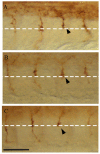Collagen XIXa1 is crucial for motor axon navigation at intermediate targets
- PMID: 21098567
- PMCID: PMC2990213
- DOI: 10.1242/dev.051730
Collagen XIXa1 is crucial for motor axon navigation at intermediate targets
Abstract
During development, motor axons navigate from the spinal cord to their muscle targets in the periphery using stereotyped pathways. These pathways are broken down into shorter segments by intermediate targets where axon growth cones are believed to coordinate guidance cues. In zebrafish stumpy mutants, embryonic development proceeds normally; however, as trunk motor axons stall at their intermediate targets, suggesting that Stumpy is needed specifically for motor axon growth cones to proceed past intermediate targets. Fine mapping and positional cloning revealed that stumpy was the zebrafish homolog of the atypical FACIT collagen collagenXIXa1 (colXIX). colXIX expression was observed in a temporal and spatial pattern, consistent with a role in motor axon guidance at intermediate targets. Knocking down zebrafish ColXIX phenocopied the stumpy phenotype and this morpholino phenotype could be rescued by adding back either mouse or zebrafish colXIX RNA. The stumpy phenotype was also partially rescued in mutants by first knocking down zebrafish ColXIX and adding back colXIX RNA, suggesting that the mutation is acting as a dominant negative. Together, these results demonstrate a novel function for a FACIT collagen in guiding vertebrate motor axons through intermediate targets.
Figures






Similar articles
-
Slow Muscle Precursors Lay Down a Collagen XV Matrix Fingerprint to Guide Motor Axon Navigation.J Neurosci. 2016 Mar 2;36(9):2663-76. doi: 10.1523/JNEUROSCI.2847-15.2016. J Neurosci. 2016. PMID: 26937007 Free PMC article.
-
Mutations in the stumpy gene reveal intermediate targets for zebrafish motor axons.Development. 2000 Jun;127(12):2653-62. doi: 10.1242/dev.127.12.2653. Development. 2000. PMID: 10821763
-
PlexinA3 restricts spinal exit points and branching of trunk motor nerves in embryonic zebrafish.J Neurosci. 2007 May 2;27(18):4978-83. doi: 10.1523/JNEUROSCI.1132-07.2007. J Neurosci. 2007. PMID: 17475806 Free PMC article.
-
Motor axon pathfinding.Cold Spring Harb Perspect Biol. 2010 Mar;2(3):a001735. doi: 10.1101/cshperspect.a001735. Cold Spring Harb Perspect Biol. 2010. PMID: 20300210 Free PMC article. Review.
-
Axon pathfinding for locomotion.Semin Cell Dev Biol. 2019 Jan;85:26-35. doi: 10.1016/j.semcdb.2017.11.014. Epub 2017 Nov 14. Semin Cell Dev Biol. 2019. PMID: 29141181 Review.
Cited by
-
Notum homolog plays a novel role in primary motor innervation.J Neurosci. 2013 Jan 30;33(5):2177-87. doi: 10.1523/JNEUROSCI.3694-12.2013. J Neurosci. 2013. PMID: 23365253 Free PMC article.
-
Chondrolectin mediates growth cone interactions of motor axons with an intermediate target.J Neurosci. 2012 Mar 28;32(13):4426-39. doi: 10.1523/JNEUROSCI.5179-11.2012. J Neurosci. 2012. PMID: 22457492 Free PMC article.
-
Frizzled3 controls axonal development in distinct populations of cranial and spinal motor neurons.Elife. 2013 Dec 17;2:e01482. doi: 10.7554/eLife.01482. Elife. 2013. PMID: 24347548 Free PMC article.
-
Robo2 Drives Target-Selective Peripheral Nerve Regeneration in Response to Glia-Derived Signals.J Neurosci. 2022 Feb 2;42(5):762-776. doi: 10.1523/JNEUROSCI.1528-21.2021. Epub 2021 Dec 16. J Neurosci. 2022. PMID: 34916258 Free PMC article.
-
Netrin signaling breaks the equivalence between two identified zebrafish motoneurons revealing a new role of intermediate targets.PLoS One. 2011;6(10):e25841. doi: 10.1371/journal.pone.0025841. Epub 2011 Oct 7. PLoS One. 2011. PMID: 22003409 Free PMC article.
References
-
- Beattie C. E. (2000). Control of motor axon guidance in the zebrafish embryo. Brain Res. Bull. 53, 489-500 - PubMed
-
- Beattie C. E., Eisen J. S. (1997). Notochord alters the permissiveness of myotome for pathfinding by an identified motoneuron in embryonic zebrafish. Development 124, 713-720 - PubMed
-
- Beattie C. E., Raible D. W., Henion P. D., Eisen J. S. (1999). Early pressure screens. Methods Cell Biol. 60, 71-86 - PubMed
-
- Beattie C. E., Melancon E., Eisen J. S. (2000). Mutations in the stumpy gene reveal intermediate targets for zebrafish motor axons. Development 127, 2653-2662 - PubMed
-
- Beattie C. E., Granato M., Kuwada J. Y. (2002). Cellular, genetic, and molecular mechanisms of axonal guidance in the zebrafish. Results Probl. Cell Differ. 40, 252-269 - PubMed
Publication types
MeSH terms
Substances
Grants and funding
LinkOut - more resources
Full Text Sources
Other Literature Sources
Molecular Biology Databases
Miscellaneous

